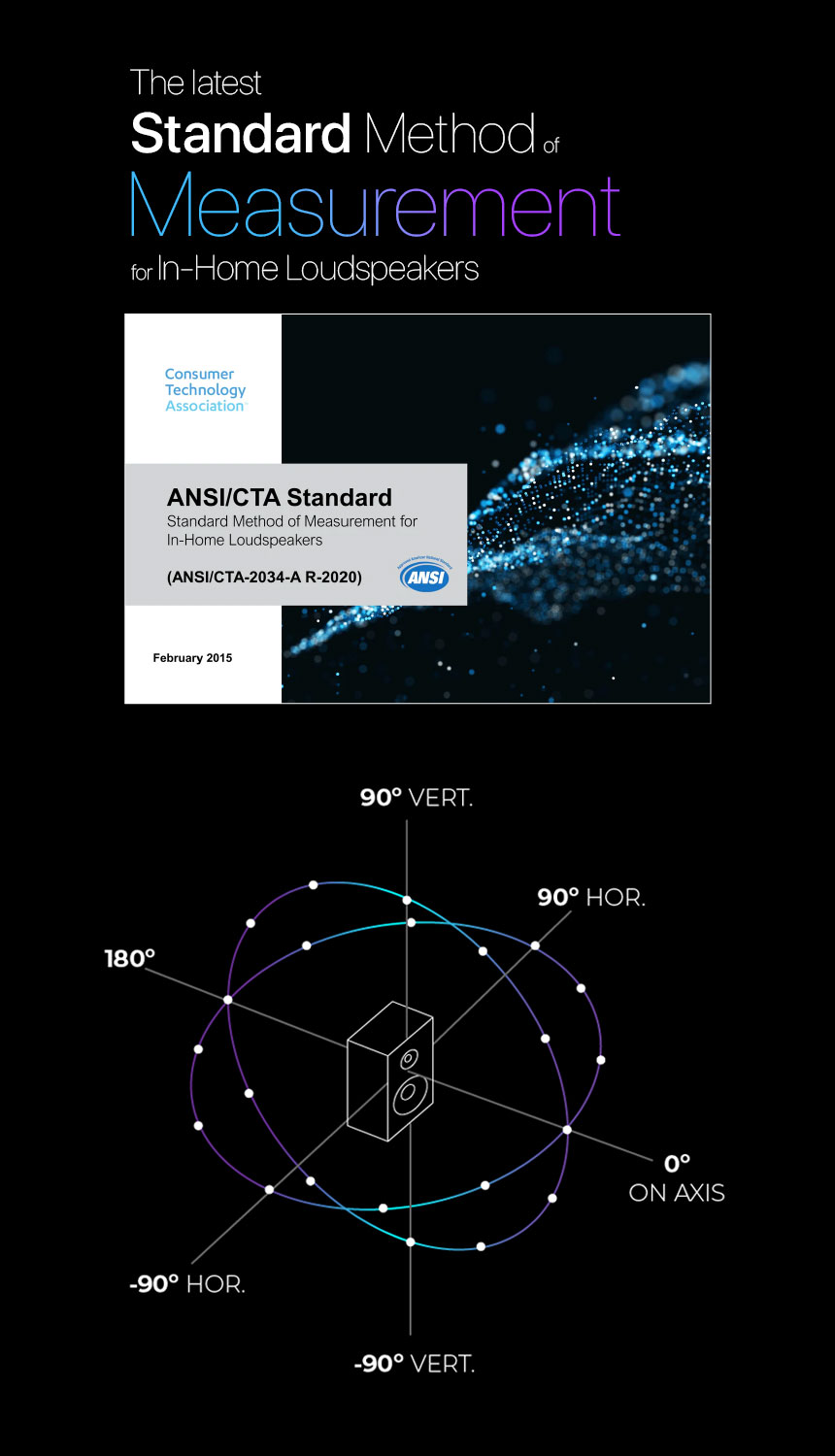New models with leading technology and exciting performance are coming soon!
The 70 microphone locations
used to acquire the amplitude response data,
according to the “ANSI/CTA-2034 Standard:
Standard Method of Measurement for
In-Home Loudspeakers"
A fundamental characteristic of a speaker, is its frequency response. Ideally, the frequency response of a loudspeaker should be flat across the audio spectrum and in all directions of space.
The most common method of measuring the frequency response of a speaker is On-Axis frequency response in an anechoic chamber, where we place the measuring microphone directly in front of the speaker.
However, for the full mapping of a speaker’s frequency behavior in space, the On-Axis Response is not sufficient enough. We must measure and record in detail the frequency response curves in all directions around the speaker.
Sound Power is the sum of the total emitted acoustic energy of a speaker as measured globally (at 360 °, with measurements every 10 °) around the speaker horizontally and vertically. Hence it is much more representative of how the speaker will aurally stimulate the listening space creating reflections, compared to the anechoic on Axis frequency response measurement.
The On Axis response reveals the speaker’s behavior just in front of it and only at a short distance from it (nearfield), whilst in a room, moving away from a speaker increases the ratio of reflected to direct sound.
The Sound Power response becomes more important for the actual In-Room response.
Published in February 2015, by Consumer Technology Association.
The ANSI/CTA-2034 standard describes an improved method for measuring and reporting the performance of a loudspeaker in a manner that should:
· help consumers better understand the performance of the loudspeaker and
· convey a reasonably good representation of how it may sound in a room
based on its off-axis response and how this response affects the consumer’s experience.
The Consumer Technology Association (CTA) is a standards and trade organization for the consumer electronics industry in the United States. CEA works to influence public policy, holds events such as the International CES and SINOCES, conducts market research, and helps its members and regulators implement technical standards.
Consumer Technology Association (CTA) Standards, Bulletins, and other technical publications are designed to serve the public interest through eliminating misunderstandings between manufacturers and purchasers, facilitating interchangeability and improvement of products, and assisting the purchaser in selecting and obtaining with minimum delay the proper product for his particular need.
The American National Standards Institute (ANSI) is a private non-profit organization that oversees the development of voluntary consensus standards for products, services, processes, systems, and personnel in the United States. The organization also coordinates U.S. standards with international standards so that American products can be used worldwide.
ANSI is the U.S. representative at the International Organization for Standardization (ISO) and
the International Electrotechnical Commission (IEC).
The 70 microphone locations
used to acquire the amplitude response data,
according to the “ANSI/CTA-2034 Standard:
Standard Method of Measurement for
In-Home Loudspeakers"
A fundamental characteristic of a speaker, is its frequency response. Ideally, the frequency response of a loudspeaker should be flat across the audio spectrum and in all directions of space.
The most common method of measuring the frequency response of a speaker is On-Axis frequency response in an anechoic chamber, where we place the measuring microphone directly in front of the speaker.
However, for the full mapping of a speaker’s frequency behavior in space, the On-Axis Response is not sufficient enough. We must measure and record in detail the frequency response curves in all directions around the speaker.
Sound Power is the sum of the total emitted acoustic energy of a speaker as measured globally (at 360 °, with measurements every 10 °) around the speaker horizontally and vertically. Hence it is much more representative of how the speaker will aurally stimulate the listening space creating reflections, compared to the anechoic on Axis frequency response measurement.
The On Axis response reveals the speaker’s behavior just in front of it and only at a short distance from it (nearfield), whilst in a room, moving away from a speaker increases the ratio of reflected to direct sound.
The Sound Power response becomes more important for the actual In-Room response.
Published in February 2015, by Consumer Technology Association.
The ANSI/CTA-2034 standard describes an improved method for measuring and reporting the performance of a loudspeaker in a manner that should:
· help consumers better understand the performance of the loudspeaker and
· convey a reasonably good representation of how it may sound in a room
based on its off-axis response and how this response affects the consumer’s experience.
The Consumer Technology Association (CTA) is a standards and trade organization for the consumer electronics industry in the United States. CEA works to influence public policy, holds events such as the International CES and SINOCES, conducts market research, and helps its members and regulators implement technical standards.
Consumer Technology Association (CTA) Standards, Bulletins, and other technical publications are designed to serve the public interest through eliminating misunderstandings between manufacturers and purchasers, facilitating interchangeability and improvement of products, and assisting the purchaser in selecting and obtaining with minimum delay the proper product for his particular need.
The American National Standards Institute (ANSI) is a private non-profit organization that oversees the development of voluntary consensus standards for products, services, processes, systems, and personnel in the United States. The organization also coordinates U.S. standards with international standards so that American products can be used worldwide.
ANSI is the U.S. representative at the International Organization for Standardization (ISO) and
the International Electrotechnical Commission (IEC).
Crystal Clear Advantages
Best Value for Money
Innovation
Quality
Style










